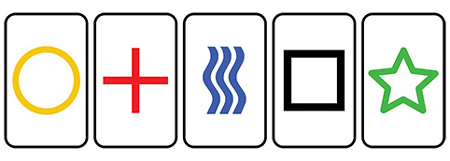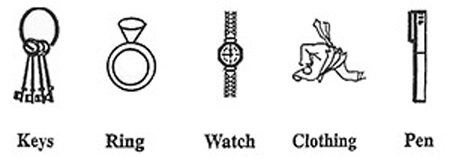Entangled minds: telepathically entering another person’s lucid dreams (1)
by Rev. Dr. Gary Duncan
In the late 1970s I read the research on dream telepathy conducted at Maimonides Medical Center’s Dream Laboratory in New York.1 I was fascinated with how a person could send pictures into the minds of sleeping subjects during dream sleep, also called Rapid Eye Movement or REM sleep. The sleeping subjects would incorporate aspects of a sent picture into their dream motifs or dream stories.

In one target picture there were two men in a boxing match, the sender or agent also had on display in his office “a genuine dark-brown leather boxing glove.”2 The picture and the physical object on display enhanced the telepathic transfer more significantly than the picture alone.
This research got me interested in dreamwork and a year later I began studying methods on how to control my dreams.3 At the time I was having an unusual recurring dream and thought dream control would help me explore it. However, this endeavour fell short of what I expected. I continued working on dream control, and added to my dream retinue Freudian and Jungian dream interpretation. I also discovered dream control was the antecedent to experiencing lucid dreams.
By the mid-1980s more research into the nature of lucid dreaming had accumulated accompanied with new methods on how to experience a lucid dream.4 Now somewhat successful with controlling my dreams, I decided to try one of the new techniques, and it worked; I was becoming more consciously aware in my dream states. But remembering and staying conscious in my dreams was a constant struggle. During this period Joe, a long time friend, and I decided to experiment dream telepathy with some symbols. Joe was a night owl, so while I slept he attempted to send these symbols into my dreams randomly, one symbol per night. After several months without success we stopped the experiment.
Shortly thereafter I began teaching a course at the University of Cincinnati, ‘Dreams: The Night Theatre’. By the seventh week of class I noticed some of the students began sharing aspects of each other’s dreams. Each time I taught the course this phenomenon would occur. I finally concluded these students unconsciously were telepathically transferring dream information into each other’s dreams, changing the dream motifs. Eventually I discovered research into this phenomenon called shared dreaming or mutual dreaming.5
If these students could telepathically send information into each other’s dreams, then why was my earlier experiment with Joe not successful? I decide to restructure the experiment with another friend, Mike, who was deeply interested in the mystical, and like Joe, we had a deep rapport. In the new experiment, we used black and white standard ESP card symbols as the targets. We decided to send these symbols into each other’s dreams telepathically. If that worked then we would attempt to enter each other’s dream motifs, a shared dream experience. Each night we randomly selected one of the ESP symbols and then telepathically focused on sending that symbol into each other’s dreams. We alternated nights, one night I would be the sender and the next night would be Mike’s turn. After a year with no successes we stopped the experiment.
A few years later I became friends with Aaron who was in the counselling profession like myself and had a deep interest in parapsychology. I presented the research on dream telepathy, lucid dreaming and shared dreaming, and he was fascinated with the idea of sharing a dream story. Rather than trying to send symbols into each other’s dreams, we instead used a different approach. Aaron would try to send his image telepathically into my dreams, and over the next year we experimented with this shared dreaming technique without success. With these experimental failures, I sat the entire project aside.
Entangled minds
Hector (pronounced Ector) and I had known each other for four years and we had discussions on various topics. The topic of choice was always the afterlife and the supernatural. Being from Mexico, Hector had a very different perspective on reality because in his culture the supernatural is a part of everyday life. One topic that kept cropping up was how everything that exists is interconnected or entangled with everything else.
The concept of entanglement comes from quantum physics in which particles created at the same time become entangled with each other. What is done to one particle instantly happens to the other particle, no matter how far apart they are. Studying entanglement, I stumbled upon Dean Radin’s (2006) concept of entangled minds.6 Radin used entangled minds to explain ESP phenomena, and his theoretical explanations gave me a scientific basis for how everything is interconnected, especially our minds.

Figure 1: Zener cards are commonly used to conduct experiments for extrasensory perception (ESP). The cards were used in author Gary Duncan’s dream experiment with mexican coleague Hector.
Hector could not wrap his head around the entanglement concept. I would tell him, he and I are a part of each other, we are a part of everything that exists and everything is entangled with everything else including our minds; we are all one. In talking to him about how we are all interconnected and entangled with each other, I began thinking about my previous failed experiments with dream telepathy and shared dreaming and why those experiments didn’t work. A successful telepathic experiment would convince Hector we are all interconnected and our minds are indeed entangled.
Now that I had piqued Hector’s interest, I decided to approach him about conducting an experiment that would test the entanglement idea, and he was interested. How would I go about the experiment? What would I do different this time that I didn’t do before? I finally came to a simple experimental protocol. I would again use standard ESP symbols but this time they would be in colour.
Hector would be the sender/agent and I would be the receiver/subject. My reasoning for this decision was Hector spoke English with a deep accent, many words he had problems pronouncing, but he understood more than he could speak. I thought his language issues and his cultural background might be an asset because he was unsullied by the rational materialistic culture of the United States.
If Hector was able to send me an ESP symbol telepathically and if I received the image, that would indicate we are entangled in some way. But if the experiment failed then my argument would fall apart. I presented the experimental protocol and he was ready and excited to begin. I, on the other hand, was a bit anxious because of the previous failures, but decided the experiment might work because we had a deep rapport with each other and our cultural backgrounds were so different.
I gave Hector the coloured ESP symbols (see Figure 1) and instructed him to choose one each week at random. Once chosen, throughout the day he pictured me in his mind and visualised the ESP symbol going from his mind into my mind. At week’s end I would call him and tell him what symbol came into my mind. He would confirm if I hit or missed the symbol. The first three days of the first week I missed the target completely and then started to get hits off and on throughout the day. Over the next two weeks, I got hits every day and a few misses, but more hits than misses. He was impressed with our experimental results and so was I.

I decided to change the targets from ESP colour symbols to pictures of black and white physical objects (see Figure 2, above). Hector continued with the same experimental protocol and I did not get a single hit. What was it about the ESP colour symbols that were easier for Hector to transmit telepathically? And why was I able to receive the ESP coloured symbols and not the black and white pictures of physical objects? Did it have to do with how he culturally perceived these symbols and objects as he telepathically transmitted them to me? Did it have to do with the fact that the black and white pictures were more detailed than the ESP coloured symbols? I was at a loss to explain these results. After a week and a half of nothing but misses, we decided to take four months off and then resume with the ESP colour symbols to see if there were any changes.
We resumed the experiment for a four-week period and every day, throughout the day, I got hits. I soon discovered that when Hector sent the ESP symbols telepathically he focused mostly on the colour that made up the symbol. In the experiments it appeared the colour of the symbol was the salient factor for successful telepathic transmission. I realised Hector is a visual learner, so cognitively the colour of an object might carry more visual weight than black and white objects.
Hector was amazed with our results but could not understand how it all worked. I tried to explain it the best I could by simplifying Dean Radin’s theoretical perspective, but fell short because of our language barrier. It became obvious we were now more than ever interested in continuing our research into entangled minds, but where would we go from here? Out of three previous attempts with three different people, Hector is the first experimental colleague to be able to telepathically send ESP symbols into my mind.
Read the second part of the article
Footnotes
1. Montague Ullman & Stanley Krippner, Dream Telepathy: Experiments in Nocturnal ESP, Penguin, 1974
2. Ibid., 121
3. Patricia L. Garfield, Creative Dreaming, Simon & Schuster, 1975 & 1995 (updated edition)
4. Stephen LaBerge, Lucid Dreaming, Ballantine, 1985
5. Linda Lane Magallon, Mutual Dreaming, Pocket Books, 1997; Barbara Shor, ‘The Promise of Shared Dreaming’, Gnosis Magazine, Winter, 1992, 36-42
6. Dean Radin, Entangled Minds: Extrasensory Experiences in a Quantum Reality, Paraview, 2006
yogaesoteric
September 21, 2019
